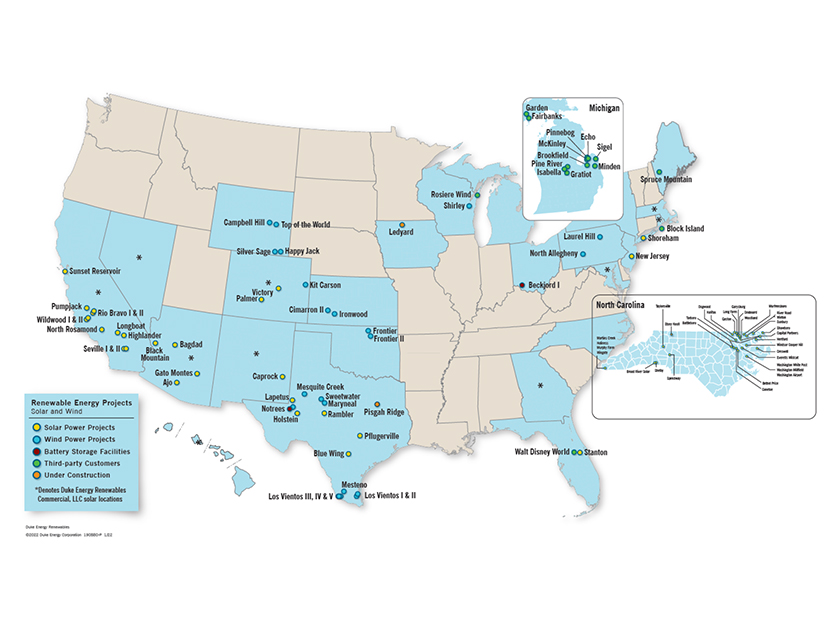
Duke Energy (NYSE:DUK) put a “for sale” sign on its 3.5-GW commercial renewable business Thursday, saying it wants to focus its capital on regulated spending.
The company has about 5.1 GW of wind and solar in operation, with net ownership of 3.5 GW and a book value estimated at $4 billion. That puts Duke among the top 10 wind and solar operators in the U.S. and has helped it gain experience in renewable energy development and operations that it will rely on in the future.
But the unit represents less than 5% of the company’s profits, generating $46 million in adjusted earnings for the second quarter.
Competition for Capital
“As we look forward to the remainder of this decade and beyond, we have line of sight to significant renewable grid and other investment opportunities within our faster growing regulated operations,” CEO Lynn Good said during the company’s second-quarter earnings call. “We believe this is the right time to step back and really look at the strategic fit of the commercial business, because there’s going to be competition for capital at Duke.”
The company is projecting an adjusted per-share growth rate of 5 to 7% through 2026.
The renewable business includes a pipeline of 1 to 1.5 GW “that could be quite valuable in 2024-2025, in addition to what we had planned for 2023,” Good said.
The company expects to conclude its review by the end of 2022 or early 2023. Sale proceeds would be used to avoid debt and postpone the need for raising equity, Good said.
NC Carbon Plan
The company will need capital, in part, to fund the new solar, battery storage, onshore wind and “hydrogen-capable” natural gas the company wants to add as part of the proposed carbon plan it filed with the North Carolina Utilities Commission on May 16. The plan also seeks permission to begin early development of long lead-time resources needed in the early 2030s, including offshore wind, pumped storage and small modular nuclear reactors (SMRs).
Good said Duke is working on SMRs “in an advisory capacity” by lending its operating expertise. The company operates the largest regulated nuclear fleet in the U.S., producing about half of its power in the Carolinas.
“We do not have an intention of being Version 1 of anything,” she said. “We would like to see a broader adoption of the technologies, a broader understanding of not only operating characteristics, but the commercial attributes — a price — and the ability to construct them within a time frame that we’re comfortable with. And so we see the decade of the 2020s as an important one to continue that work. And if it progresses, as we all hope it does, we would be in a position to potentially invest in one to come into service in the early 2030s.”
Good indicated that neither supply chain problems in the solar industry nor rising natural gas prices have led the company to rethink its coal retirement plans. “Frankly … the logistics of getting coal from point A to point B are also a challenge,” she said, citing labor shortages in railroads and mining companies.
Inflation Reduction Act, Load Trends
Good said the U.S. Senate’s proposed Inflation Reduction Act would benefit the commercial renewables business and save customers money through the nuclear production tax credit. “We will be impacted by the [15%] corporate minimum tax, but we will also benefit from the credits which will pass to our customers,” Good said.
Duke said it expects its 2022 load growth to be above its initial projection of 1.5%. But CFO Steve Young said the company is continuing to project minimal load growth over its five-year planning horizon as it balances the impact of electrification against energy efficiency.
Good said that while the company is basing its spending on assumptions of little additional load growth, migration trends in the Southeast give it “some tailwinds on growth that I think we’ll enjoy for a period of time.”
“But we continue to believe that flat to 0.5% is the best way to manage the business and always hope to be surprised to the upside,” she added.
Q2 Results
Duke reported GAAP second-quarter earnings of $893 million ($1.14/share) versus $751 million ($0.96/share) in 2021. Adjusted earnings were identical to GAAP results for 2022, a drop from $898 million ($1.15/share) for 2021.
Lower 2022 adjusted earnings resulted from higher operations and maintenance expenses from plant outage timing, higher interest costs and the impact of Singapore-based GIC’s 2021 purchase of 11.05% of Duke Energy Indiana.



